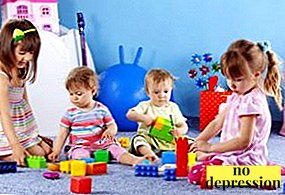Vain memory too can be developed and made stronger.
Moreover, as in the case of muscles, the earlier you start training, the more tangible and longer the result will be.
At the same time, it is not at all necessary to resort to particularly complex activities. Great success lies in systematicand not in the intricacies of techniques.
Memory training: a definition from the point of view of psychology

This is a series of actions with the use of scrap materials or without them to improve the ability to manage their attention and instant, short-term and long-term memory.
The success of the training is determined by:
- the acquisition or restoration of the ability to memorize information of interest from a different plan with minimal effort;
- the ability to easily use at any time the entire amount of data for which additional efforts were made to remember;
- reduce the manifestation of symptoms of age-related changes that affect the ability of effective mental work.
Development techniques
Simply put, the quality of the memory is in close dependence on personal base of associative connections person
The wider his experience, accumulated as a result of all actions in life, the better the state of memory (provided there is no pathology affecting the human psyche and nervous system).
Therefore, many techniques for improving the ability to perceive and memorize data include skill to connect information of interest with existing knowledge about something, someone.
Attracting emotions

To make the mastered volume easier to remember, pre-create a positive mood from the awareness of the practical application of the memorized information.
Anticipation of the good helps to resist the boredom, encompassing upon acquaintance with impersonal data and impairing the memorization process.
Another option for applying the method is to involve real enjoyable action while memorizing something.
For example, while indulging yourself in the process of studying with candies, and even better with fruits and berries of a certain taste, you can further achieve that the learned material comes to mind every time when you not only try this delicacy, but also just think about it.
Structuring data
The amount of data is conventionally divided into blocks, which are then arranged in a chain, where the location of each individual object is associated with:
- The subject in the presented interior is a well-known room. This method among specialists is called "Roman room".
Figuratively speaking, the association of a separate piece of information with a well-studied object from the real world allows the brain to quickly find the necessary block in its mental archives on demand.
- The remaining blocks on the principle causal relationship. For example, a glass, under normal conditions, stands on the table. This means that you first need to remember the characteristics of the piece of furniture, and only then alternately pay attention to the things on it.
Using Binding to Nonstandard Associations

With good fantasy It is easy to imagine the connection of a separate part of the memorized data with something extraordinary and in general from another topic.
Assume that you need to remember the description of the type of KAMAZ.
Having imagined it on Malibu beach, “seeing” how its red cabin contrasts with creamy sand background, how sun glares play in the high-gloss glass of headlights and enhance the white radiance of the exterior panel.
Conscious craving
Choosing a similar path of memory training, remember:
- Hours-long "chewing" of the text is dead end. Engage in the material in the morning hours immediately after lifting.
If necessary, get up 30 minutes earlier than usual and while your head is fresh, brainstorm.
- Before bedtime run through the eyes again of the material with which they met in the morning.
Methods of mnemonics

This way of storing information is similar to cryptographic combinations that people who are fond of conspiracy.
The technique includes four sequential steps:
- conversion of a single value into an image;
- making pairs of them;
- the alignment of the resulting associations of a chain with a strictly defined arrangement of individual links-pairs;
- fixing the result in memory.
The easiest way to understand the essence of technology is by using the conversion of numbers to a combination of letters — some long values. easier to remember when they are expressed verbally.
And in most cases, the resulting "statements" are meaningless - their practical value lies only in the sequence of letters.
Example
Numbers from 0 to 9 are assigned a literal expression. As a result, the digital series corresponds to the symbols H, P, D, T, Ch, P, W, C, B, M, where "H" and "M" are zero and nine (because they are many), and the remaining values match the name of the hotel number: “P” is “one”, that is, “1”. And so on.
Another option for memory memory is based on the connection between the words and the first letters in each of them with the additionally assigned value.

To improve the result, it is desirable to make the expression in poetic form.
Who does not know a poem about a hunter who dreams of finding out the location of a pheasant?
And they came up with it to simplify the memorization of a combination, avoiding confusion with the right arrangement of colors in the rainbow.
How to improve memory and attention in adults?
Care, stress, chronic sleep deprivation often lead to memory impairment and inability to concentrate for a long time.
If a long and full rest does not eliminate the problem, become a personal trainer of your own brain - close cooperation will bring tangible benefits to both sides of the process.
It is not necessary to dive from a run-up and without professional support into complex memory training techniques. Good results give the most simple exercises with an algorithm that is understandable even for children.
Move to more challenging tasks. need with obvious improvement in results and maintaining the desire to further empower your memory.
Using the familiar interior

It would seem that it is difficult to reproduce from memory the furnishings in your room?
If with a banal listing coped to the "5" - the answers are better to write, complicate the task.
Describe the particularly bright details of each object, and then list the less memorable.
A slightly different task with the same attributes: you need not to list the surrounding objects by memory, but to call them, considering the situation. Sounding should take place incrementally - as practice shows, this is not so simple.
Life is the opposite
In traffic jam, the queue to see a specialist engage yourself in mind reading the words - very useful for systematic stupid states, when you yourself understand that the smell of "burning rubber" is about to become noticeable even to those around you.
After 5 minutes of classes, feel how a little changed your view of the world and from then on it is easier to focus even on difficult tasks.
In a couple of weeks you will feel that memory already brings less and easier to cope with the assimilation of solid amounts of data.
Retelling

Using first artistic, and then technical subjects of the book, choose at random a small paragraph for 3-5 sentences, carefully re-read it several times.
Then recite to memory, trying to reproduce the text verbatim.
Reading ordinary books
The electronic format of knowledge is more convenient and easier, but we have evolved for thousands of years without gadgets, so our mental abilities, figuratively speaking, depend on the information received in the old-fashioned way - reading from paper.
Learning
Poems, phone numbers friends, shopping list for the current day, complex drug names or chemicals.
Do not be afraid to overload the brain: under normal circumstances, when a person is resting enough, he regularly goes in for sports and drinks the volume of pure ordinary water recommended for his body weight, it is unreal to overload the brain.
How to develop memory and thinking in children?
Children's brain is tuned to the perception of the maximum amount of data. Especially good fixation occurs when a child is interested in learning information. This is best achieved during entertainment. Therefore, memory training is more effective in a game format.
Memorize and write

Getting to kindergarten, school, shop, learn funny poems or write them yourself.
Writing them down or sketching in the form of characters in a special notebook will help develop imagination and associative memory.
Train your long-term memory
In the evenings, it is possible before bedtime, ask the child about the unusually dressed people whom he saw, especially interesting entertainment during the day, cars parked near the front door.
The more diverse the questions, the more attention the child will pay to the details surrounding him in life.
Collect puzzles
For the first steps in the art of drawing up a whole picture of scattered pieces, choose sets with relatively small number of small parts in drawing.
Over time, the child himself wants more complex tasks. And in the first couple, they can even discourage the desire to develop a figurative perception of the world.
Control “communication” with a computer or smartphone
Electronic devices are created to simplify our lives. But this is their property. doing and disservice: we are gradually losing the desire to strain our memory because of the possibility at any time to find an interesting answer on the web.
Offer games for the development of fine motor skills

Finger flexibility and obedience affects the state of the intellecttherefore, all kinds of modeling, constructors, drawing are useful both for the development of taste and the ability to memorize and recognize.
As soon as the first precursors of serious memory problems appear: it is difficult to enumerate the events of the past day, it is difficult to remember relatively complex digital combinations, start to deal with the problem.
Preventive measures will not require much effort and resources, but they allow you to postpone or even avoid the helplessness inherent in a person with a memory compared to a “sieve”.
Exercises to improve memory and increase attention:



